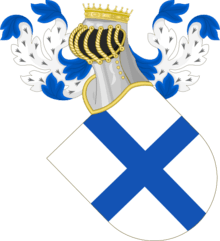Ferdinand I of Portugal
| Ferdinand I | |
|---|---|
 Engraving of Ferdinand; Pedro Perret, 1603. | |
| King of Portugal and the Algarve | |
| Reign | 18 January 1367 – 22 October 1383 |
| Predecessor | Peter I |
| Successor | John I |
| King of Castile (in Galicia) In opposition to Henry II | |
| Reign | 1369 – 1371 |
| Predecessor | Peter I |
| Successor | Henry II |
| Born |
31 October 1345 Coimbra, Kingdom of Portugal |
| Died |
22 October 1383 (aged 37) Lisbon, Kingdom of Portugal |
| Burial | Carmo Convent, Lisbon, District of Lisbon, Portugal |
| Spouse | Leonor Telles de Meneses |
| Issue among others... | Beatrice of Portugal |
| House | House of Burgundy |
| Father | Peter I |
| Mother | Constanza Manuel |
| Religion | Roman Catholicism |
Dom Ferdinand I (Portuguese: Fernando;[1] 31 October 1345 – 22 October 1383), sometimes called the Handsome (o Formoso or o Belo ) or occasionally the Inconstant (o Inconstante), was the King of Portugal and the Algarve from 1367 until his death in 1383. His death led to the 1383-85 crisis, also known as the Portuguese interregnum.
Life
Ferdinand was born in Coimbra, the second but eldest surviving son of Peter I and his wife, Constanza Manuel.[2] On the death of Peter of Castile in 1369, Ferdinand, as great-grandson of Sancho IV by the female line, laid claim to the vacant Castilian throne. The kings of Aragon and Navarre, and later John of Gaunt, Duke of Lancaster, who had married Peter of Castile's eldest daughter, Constance, also claimed the throne.
The throne was held by Henry of Trastámara (Henry II of Castile), Peter of Castile's illegitimate brother, who had defeated him in the Castilian Civil War in 1366 and assumed the crown. After one or two indecisive campaigns, all parties were ready to accept the mediation of Pope Gregory XI. The conditions of the treaty, ratified in 1371, included a marriage between Ferdinand and Leonora of Castile. But before the union could take place Ferdinand had become passionately attached to Leonor Telles de Meneses, the wife of one of his own courtiers. Having procured a dissolution of her previous marriage, he lost no time in making Leonor his queen.[2]
_(late_15th_C)%2C_f.217v_-_BL_Royal_MS_14_E_IV.png)
This conduct, although it raised a serious insurrection in Portugal, did not at once result in a war with Henry. However, the outward concord was soon disturbed by intrigues with the Duke of Lancaster, who entered into a secret treaty with Ferdinand for the expulsion of Henry from his throne. The war which followed was unsuccessful; and peace was again made in 1373.
On the death of Henry in 1379, the Duke of Lancaster once more put forward his claims, and again found an ally in Portugal. According to the Continental annalists, the English proved as offensive to their allies as to their enemies in the field. So Ferdinand made a peace for himself at Badajoz in 1382. It stipulated that Beatrice, Ferdinand's daughter and heiress, would marry King John I of Castile, and thus secure the ultimate union of the two crowns.
Ferdinand left no male heir when he died at Lisbon on 22 October 1383, and the direct Burgundian line, which had been in possession of the throne since the days of Count Henry (about 1112), became extinct. The stipulations of the treaty of Badajoz were set aside, and John, Grand Master of the order of Aviz, Ferdinand's illegitimate brother, claimed the throne. This led to a period of war and political indefinition known as the 1383-1385 Crisis. John became the first king of the House of Aviz in 1385.
Marriages and descendants
Fernando married Leonor Telles de Meneses, formerly the wife of the late nobleman João Lourenço da Cunha, Lord of Pombeiro, and daughter of Martim Afonso Telo de Meneses.
| Name | Birth | Death | Notes |
|---|---|---|---|
| By Leonor Telles de Meneses (c. 1350- 27 April 1386; married in 1371) | |||
| Infanta Beatriz | 1372 | 1408 | Heiress of her father. Married King John I of Castile, legitimate son of Henry II of Castile. |
| Infante Afonso | 1382 | 1382 | lived 4 days. |
| Daughter | 1383 | 1383 | lived a few hours. |
| Illegitimate offspring | |||
| Isabel of Portugal | 1364 | 1395 | Countess of Gijón and Noreña through marriage to Alfonso Enríquez, Count of Gijón and Noroña, illegitimate son of Henry II of Castile. |
Ancestry
| Ancestors of Ferdinand I of Portugal | ||||||||||||||||||||||||||||||||||||||||||||||||||||||||||||||||||||||||||||||||||||||||||||||||||||||||||||||||||||||||||||||||||||||||||||||||||||||||||||||||||||||||||||||||||||||||||||||||||||||||||||||||||||||||||||||||||||||||||||||||||||||||||||||||||||||||||||||||||||||||||||||||||||||||||||||||||||||||||||||||||||||||||||||||||||||||||||||||||||||||||||||||||||||||||||||||||||||||||||||||||||||||||||||||||||||||||||||||||||||||||||||||||||||||||||||||||||||||||||||||||||||||||||||||||||||||||||||||||
|---|---|---|---|---|---|---|---|---|---|---|---|---|---|---|---|---|---|---|---|---|---|---|---|---|---|---|---|---|---|---|---|---|---|---|---|---|---|---|---|---|---|---|---|---|---|---|---|---|---|---|---|---|---|---|---|---|---|---|---|---|---|---|---|---|---|---|---|---|---|---|---|---|---|---|---|---|---|---|---|---|---|---|---|---|---|---|---|---|---|---|---|---|---|---|---|---|---|---|---|---|---|---|---|---|---|---|---|---|---|---|---|---|---|---|---|---|---|---|---|---|---|---|---|---|---|---|---|---|---|---|---|---|---|---|---|---|---|---|---|---|---|---|---|---|---|---|---|---|---|---|---|---|---|---|---|---|---|---|---|---|---|---|---|---|---|---|---|---|---|---|---|---|---|---|---|---|---|---|---|---|---|---|---|---|---|---|---|---|---|---|---|---|---|---|---|---|---|---|---|---|---|---|---|---|---|---|---|---|---|---|---|---|---|---|---|---|---|---|---|---|---|---|---|---|---|---|---|---|---|---|---|---|---|---|---|---|---|---|---|---|---|---|---|---|---|---|---|---|---|---|---|---|---|---|---|---|---|---|---|---|---|---|---|---|---|---|---|---|---|---|---|---|---|---|---|---|---|---|---|---|---|---|---|---|---|---|---|---|---|---|---|---|---|---|---|---|---|---|---|---|---|---|---|---|---|---|---|---|---|---|---|---|---|---|---|---|---|---|---|---|---|---|---|---|---|---|---|---|---|---|---|---|---|---|---|---|---|---|---|---|---|---|---|---|---|---|---|---|---|---|---|---|---|---|---|---|---|---|---|---|---|---|---|---|---|---|---|---|---|---|---|---|---|---|---|---|---|---|---|---|---|---|---|---|---|---|---|---|---|---|---|---|---|---|---|---|---|---|---|---|---|---|---|---|---|---|---|---|---|---|---|---|---|---|---|---|---|---|---|---|---|---|---|---|---|---|---|---|---|---|---|---|---|---|---|---|---|---|---|---|---|---|---|---|---|---|---|---|---|---|---|---|---|---|---|---|---|---|---|---|---|---|---|---|---|---|---|---|---|---|---|---|---|---|---|---|---|---|---|---|---|---|---|---|---|---|---|---|---|---|---|---|---|---|---|---|---|---|---|---|---|---|---|---|---|---|---|---|---|---|---|---|---|---|
| ||||||||||||||||||||||||||||||||||||||||||||||||||||||||||||||||||||||||||||||||||||||||||||||||||||||||||||||||||||||||||||||||||||||||||||||||||||||||||||||||||||||||||||||||||||||||||||||||||||||||||||||||||||||||||||||||||||||||||||||||||||||||||||||||||||||||||||||||||||||||||||||||||||||||||||||||||||||||||||||||||||||||||||||||||||||||||||||||||||||||||||||||||||||||||||||||||||||||||||||||||||||||||||||||||||||||||||||||||||||||||||||||||||||||||||||||||||||||||||||||||||||||||||||||||||||||||||||||||
Bibliography
- García Oro, José (1987): Galicia en los siglos XIV y XV. Fundación "Pedro Barrie de la Maza, Conde de Fenosa", A Coruña. ISBN 84-85728-59-9. (Spanish)
References
- ↑ Portuguese pronunciation: [fɨɾˈnɐ̃du]
- 1 2 Spain and Portugal, Graeme Mercer Adam ed., J. D. Morris, 1906
External links
| Ferdinand I of Portugal Cadet branch of the Capetian dynasty Born: 8 April 1320 Died: 18 January 1367 | ||
| Regnal titles | ||
|---|---|---|
| Preceded by Peter I |
King of Portugal 1367–1383 |
Vacant Beatrice not recognized Title next held by John I |
| Preceded by Peter |
— DISPUTED — King of Galicia 1369–1371 Disputed by Henry II |
Succeeded by Henry II |
.png)
